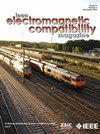改进DDR5存储器中信号完整性的连接器终端设计创新
IF 2.5
3区 计算机科学
Q3 ENGINEERING, ELECTRICAL & ELECTRONIC
IEEE Transactions on Electromagnetic Compatibility
Pub Date : 2025-01-28
DOI:10.1109/TEMC.2025.3526370
引用次数: 0
摘要
本文介绍了一种用于双数据速率第五代同步动态随机存取存储器(DDR5)连接器的创新连接器终端设计,以增强高频存储系统中的信号完整性。随着存储技术从DDR1向DDR5的发展,对更高的传输速度和更小的信号失真的要求要求更精确的终端设计。利用ANSYS高频结构模拟器进行了仿真,从阻抗、插入损耗(IL)、回波损耗和串扰(XT)等方面评估了所提出的短管设计的高频性能。实验结果证实了该设计的优越性,该设计消除了传统设计中2.16 mm的端子短段。这种改进减小了阻抗变化,在9-14.5 GHz频率范围内将IL降低了0.2-0.4 dB,并在XT测试中实现了更高的谐振频率,从而增强了信号的完整性。这些改进为高频应用带来了巨大的希望,为DDR5连接器金手指建立了新的设计范式,并为未来的高速存储接口提供了宝贵的见解。本文章由计算机程序翻译,如有差异,请以英文原文为准。
Innovations in Connector Terminal Design for Improved Signal Integrity in DDR5 Memory
This article introduces an innovative connector terminal design for double data rate fifth-generation synchronous dynamic random-access memory (DDR5) connectors to enhance signal integrity in high-frequency memory systems. With the evolution of memory technology from DDR1 to DDR5, the requirements for higher transmission speeds and less signal distortion have necessitated more precise terminal designs. Simulations were conducted using ANSYS high-frequency structure simulator to assess the proposed stub design's high-frequency performance in terms of impedance, insertion loss (IL), return loss, and crosstalk (XT). Experimental results confirmed the superiority of the proposed design, which eliminates the 2.16 mm terminal stub from the conventional design. This modification minimized impedance variation, reduced IL by 0.2–0.4 dB in the 9–14.5 GHz frequency range, and enabled higher resonant frequencies in XT tests, thus enhancing signal integrity. These improvements hold significant promise for high-frequency applications, establishing a new design paradigm for DDR5 connector gold fingers and providing valuable insights for future high-speed memory interfaces.
求助全文
通过发布文献求助,成功后即可免费获取论文全文。
去求助
来源期刊
CiteScore
4.80
自引率
19.00%
发文量
235
审稿时长
2.3 months
期刊介绍:
IEEE Transactions on Electromagnetic Compatibility publishes original and significant contributions related to all disciplines of electromagnetic compatibility (EMC) and relevant methods to predict, assess and prevent electromagnetic interference (EMI) and increase device/product immunity. The scope of the publication includes, but is not limited to Electromagnetic Environments; Interference Control; EMC and EMI Modeling; High Power Electromagnetics; EMC Standards, Methods of EMC Measurements; Computational Electromagnetics and Signal and Power Integrity, as applied or directly related to Electromagnetic Compatibility problems; Transmission Lines; Electrostatic Discharge and Lightning Effects; EMC in Wireless and Optical Technologies; EMC in Printed Circuit Board and System Design.

 求助内容:
求助内容: 应助结果提醒方式:
应助结果提醒方式:


